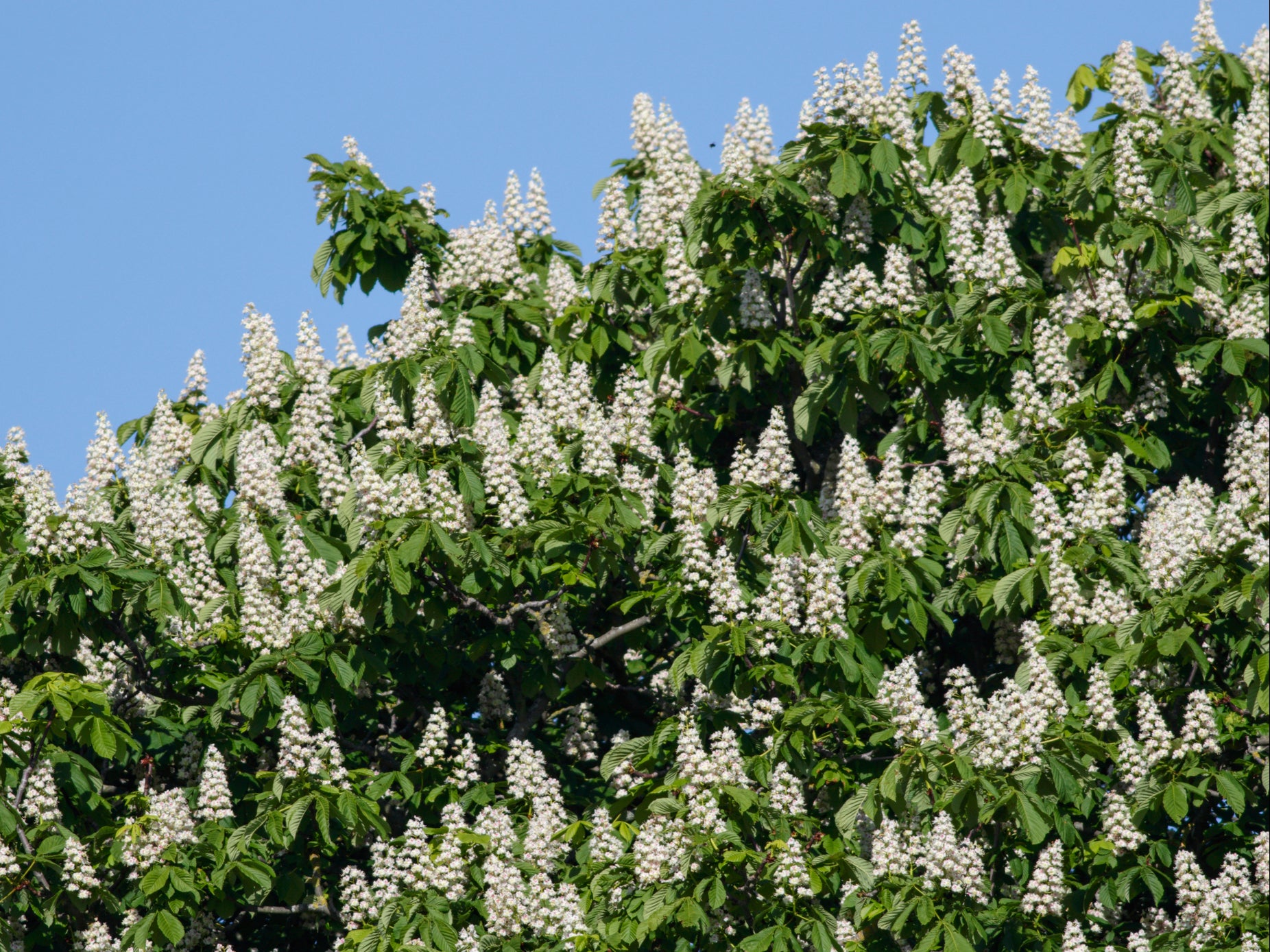Climate crisis: Growing gap between trees flowering and coming into leaf as world warms, study finds
Temperature rises appear to be affecting a delicate balancing act which maximises species survival, reports Harry Cockburn


As the world warms due to greenhouse gas emissions, trees’ delicate flowering and leafing timings, calibrated over millennia, are now changing.
Every year, trees must flower in order to pollinate themselves or each other and produce seeds.
This process can happen either before or after the new leaves unfold in spring.
New research which examined four common European tree species — ash, horse chestnut, Scots pine and alder — found that between 1950 and 2013 the interval between leaf unfolding and flowering increased by between 0.6 and 1.3 days a decade.
It means trees such as ash which flower first are flowering earlier, and the number of subsquent days until their leaves unfold could have risen by 7.8 days since in the past 10 years.
A horse chestnut, on the other hand, unfolds its leaves before the towering white candelabras of its flowers bloom afterwards. In this case, the research indicates the tree is coming into leaf earlier and there is a growing waiting period before the flowers arrive.
For trees, this gap between flowering and leaf unfurling represents a fragile balancing act which maximises their chance of survival.
If they come into flower too early, the delicate parts of the flowers vital for releasing and catching pollen can be damaged by any late frosts. If species like horse chestnut, where the leaves arrive first also unfurl their leaves too early, frost can damage the tender young leaves upon which the trees depend for the photosynthesis that powers their growth and health.
These timed changes, known as phenological events, are based on the historic climate trends the trees have evolved through, and for some trees, who depend on insect pollination rather than wind-borne pollination, the timing coincides with what is best for the pollinator insects.
The research, by an international team from the Chinese Academy of Sciences, Zhejiang A&F University and the University of Eastern Finland, also found the greatest time intervals were seen among trees in the warmer areas of Europe.
“The timing of these events is crucial for maximising fitness,” they wrote in a study published in the Journal of Ecology.
Dr Jian-Guo Huang, one of the co-authors of the research, said: “The unequal advances of leaf unfolding and flowering may alter trees’ partitioning of resources between growth and reproduction and could leave flowers or leaves vulnerable to late spring frost damage if they appear too early.
“This could have impacts on tree species health and further affect ecosystem structure and function.”
The researchers said although leaf unfolding and flowering have both been shown to be happening earlier with climate warming, this is the first large scale study to examine both phenological events in relation to one another and shows that they are not advancing at the same rate in response to climate warming — the first event is happening earlier, but the second event less so.
Dr Qianqian Ma, lead author of the study said: “The timing of phenological events is very sensitive to environmental factors, with temperature being particularly important in temperate plants.
“The changes in phenology we observed in our study may affect both growth and reproductive development in tree species and ultimately affect the ecosystem, nutrient cycles and carbon storage.”
Changes to when trees are able to grow in the year can have further consequences to their survival and carbon uptake, the authors said.
The triggering of these phenological events is closely linked to temperature changes in the seasons.
“Plants often require an exposure to chilling temperatures during winter as a cue for rest before the bursting of leaf buds or flowering can be triggered by a sufficient exposure to warmer temperatures in spring,” said Dr Qianqian Ma.
For each tree species, leaf unfolding and flowering have evolved to occur in a predetermined order. Although leaf unfolding occurs first in most species, those pollinated by wind, like alder and ash, flower first so that leaves don't inhibit pollen dispersal.
To collect the data on the four tree species, the researchers used the Pan European Phenology network. This database contains annual observations of the date when leaves first unfold (or separate for evergreens) and the date when flowers first emerge for tree species across Europe. With this data the authors calculated the time intervals between first leaf date and first flower date between 1950 - 2013 and assessed this with corresponding temperature data.
Dr Qianqian Ma said: “Using long-term phenological records in Europe, we examined simultaneously the responses of both leaf unfolding and flowering of four common temperate tree species: ash, alder, horse chestnut and scots pine to climate warming.”
These trees were chosen to give a mix of deciduous and evergreen trees with different orders of leaf unfolding and flowering.
The research team said ideally more species would have been included in the study, but they could only look at tree species with data on first leaf, first flower date and temperature. Only four tree species had sufficient data records over long enough time periods and large enough geographic areas.
Dr Jian-Guo Huang said: “Further studies that simultaneously monitor the timing of phenological events and the allocation of resources within plants are needed to better evaluate the consequences of altered phenology under climate warming.”




Join our commenting forum
Join thought-provoking conversations, follow other Independent readers and see their replies
Comments